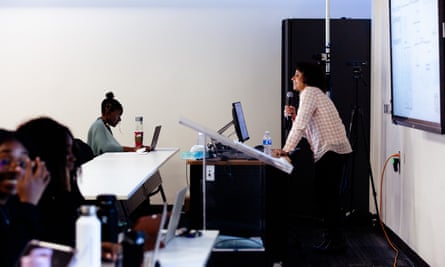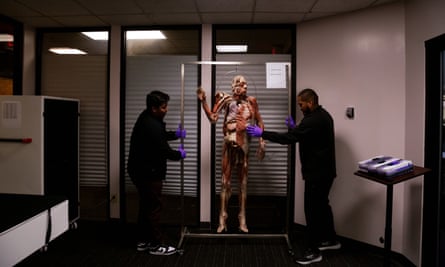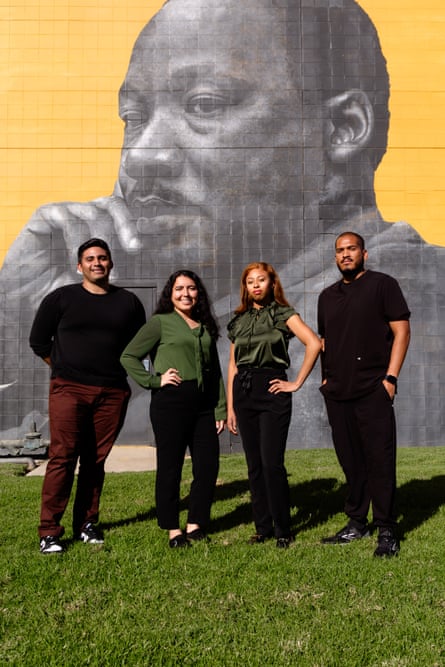Inaugural medical class at historically Black university in LA is ‘what medicine has needed’
For Sanam Ahadi's grandmother, Karima Lutfi, it was too late.
Ahadi's family, originally from Afghanistan, was afraid to take Lutfi to hospital when she contracted the Covid-19 virus early in the pandemic. The information was low. Visitor numbers were limited and the unknown was inescapable, including the potential lethality of the virus among older adults. In Lutfi's case, there was also a language barrier.
After two weeks, Lutfi's condition worsened, so Ahadi's family, who had fled war in their home country in the 1980s, took her to an emergency room in Irvine, California, a 45-minute drive from where they lived in Anaheim, hoping that help would come there. would be better resourced.
When they arrived, a doctor told them about a monoclonal antibody treatment that could have helped Lutfi. But at that moment she was too sick.
Lutfi died in hospital a week later.
This experience led Ahadi to apply for medical school with the goal of providing lifesaving medical information and care to people in communities where decades of underinvestment can manifest in preventable deaths.
“I realized this is going to happen to other people and other families,” Ahadi said. “There will always be a language barrier, there will always be health inequalities. I don't want other families to go through what I went through with my grandmother.”
In addition to helping open a monoclonal antibody transfusion center in her Anaheim neighborhood, Ahadi became one of 60 students, chosen from nearly 1,000 applicants, who formed the first class of medical students at the Charles R. Drew University (CDU) of Medicine and Science. , a private, historically black graduate school in Willowbrook, a neighborhood in southeast Los Angeles between Watts and Compton.
The university, named after a pioneering black surgeon and scientist known as the father of the modern blood bank, was founded in 1966 after the Watts Rebellion to fill gaps in medical care and bring more black doctors, nurses and researchers into the field. Since then it has become one of the nations top producers of black physicians in addition to medical schools at historically black colleges and universities (HBCUs), including Howard University and Morehouse College.
Amid the progress made by Black medical schools, the share of Black physicians in the U.S. has only increased 4% between 1900 and 2018, according to an April 2021 study analyzing historical trends published in the Journal of General Internal Medicine. In the majority Black and Latino communities surrounding CDU, having a doctor who comes from the same racial and cultural background and speaks the same language can add years to a person's life – while the lack of it can shave years off.
For decades, this lack of diverse physicians, combined with factors such as underinsured patients or insecure housing, has led to health disparities ranging from diabetic patients being more likely to develop diabetes leg or foot amputations to levels of infant mortality nearly double those in the rest of Los Angeles, according to a 2023 assessment of community health care needs by Martin Luther King Jr. Community Hospital, a safety net facility across the street from CDU serving 13% of LA County, 72% of whom rely on government-sponsored healthcare.

Before achieving accreditation in November 2022, CDU trained medical students through a partnership with the University of California, Los Angeles. But in four years, a new generation of doctors will be the first to earn a degree bearing only the name Charles Drew.
“That has always been the goal here at the university, to have our own independent medical program,” said Deborah Prothrow-Stith, dean of the medical college.

Prothrow-Stith has been dean since 2016, and in that time she has seen students become integrated into the community through a street medicine rotation, in which students provide locals with rapid HIV tests and unhoused people for health screenings. This work, Prothrow-Stith says, will prepare students for the realities of working in a field with few Black and Latino physicians and caring for people who do not have access to consistent medical care.
“We are going to prepare them as best we can for the heavy fighting,” she said. “Knowledge and lived experiences are lacking in medicine. We need this class to be very successful, and we need them to have strategies to change mindsets so that medicine does some things differently.”
after newsletter promotion
Laila Cross, a CDU student who previously worked at a Boston-area nutrition clinic for children struggling to meet growth milestones, said supportive and appropriate health care should start at birth.
“I saw how issues like poverty and systematic disenfranchisement can put you on a good track from a young age in terms of your health, or on a track where you have the potential for lifelong struggle,” she said.
Cross plans to pursue a career in maternal and child health, where she hopes to provide long-term health care for babies and children and connect families with wrap-around services, from taxi vouchers to get people to appointments to behavioral health professionals who care for the mental well-being of can support people.
“If we intervene early, we can do a lot to foster and grow a person's potential,” she said. “The more people you can bring to the table and include in the health care team to provide a variety of services, the better you can address these systemic issues.”
For the 60 students in CDU's first cohort, the focus on how factors such as housing, reliable transportation and proximity to pharmacies and clinics influence physical health was an attractive draw. Some planned to attend other schools to which they had been admitted, but turned to CDU when the university gained accreditation and later accepted students.

“I was already thinking about leaving the state, and I was sad because my heart is with the Latino and minority communities,” said Martha Romero, a CDU medical student. “I've never been out of state, but it seems very white. So when I got the CDU acceptance, I was elated.”
Growing up in Santa Ana, a predominantly Latino city in Orange County, Romero says, she watched people around her lose their limbs and vision to treatable conditions like diabetes and high blood pressure. While working for a community health program, Romero met a Latino doctor who inspired her to become a trusted source of health information for those she was related to and grew up with.
“I have seen that many misconceptions about medicine can be debunked simply by having access to someone. I want to do that for my community,” she says.
For CDU administrators, the inspiration Romero found is what they hope their medical students will share with local students and residents of South and Southeast Los Angeles. In addition to the impact on diversity in medicine, local officials and university leaders hope the medical school will boost the area's economy, create jobs on campus and bring local people into the medical field by training them to work in clinical environments, and by connecting with and mentoring students in kindergarten through 12th grade.
“There's nothing like training people from the communities they're going to serve because that's where it becomes authentic,” Prothrow-Stith says. “That's where the level of empathy and appreciation of humanity comes in. That's what medicine needs.”
